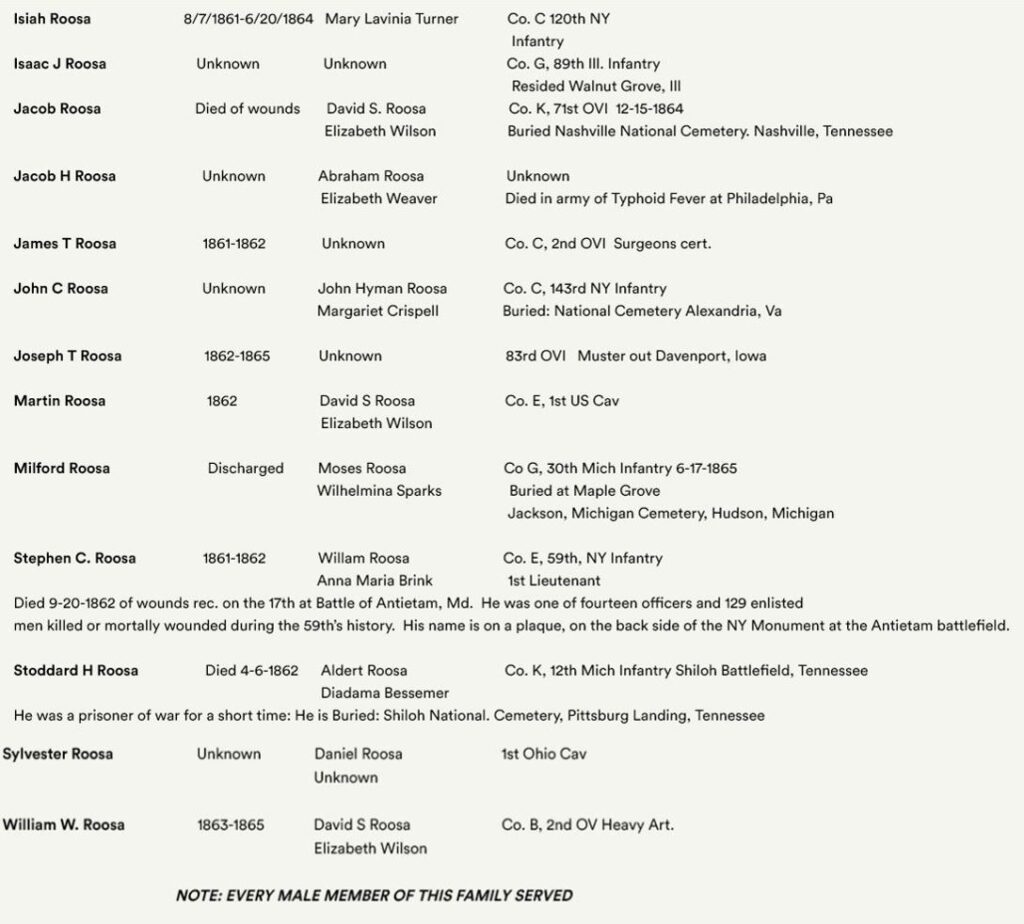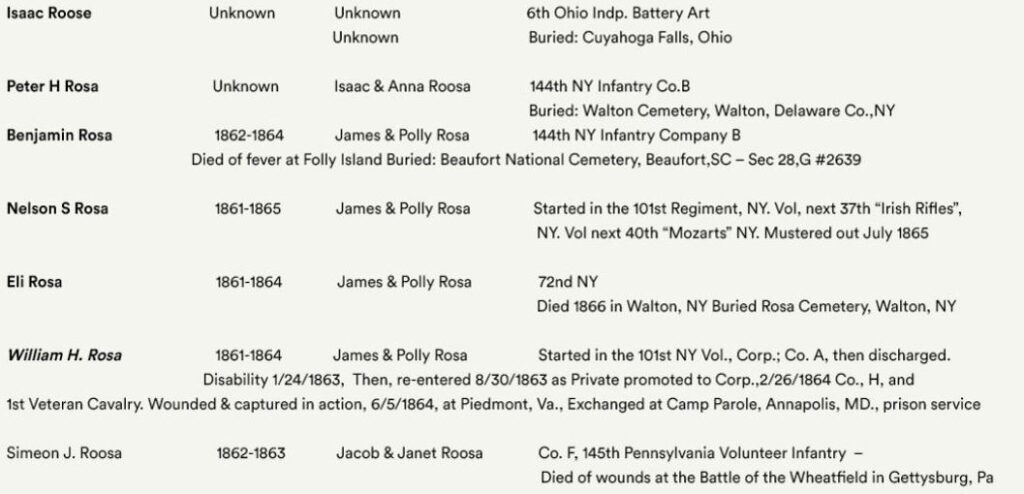Head of the Roosa Family
Aldert Heyman Roosa 1621-1679
Wyntie Ariens De Jongh 1623-1686
The head of the Roosa family in this country was Aldert Heyman Roosa born in Holland, in 1621 and his wife Wyntie Ariens De Jongh born in Holland 1623. They came to this country April 1660 on the ship called “The Spotted Cow”, with eight children, ages 17, 15, 14, 9, 8, 7, 4, and 2, respectively, and settled in Wiltwick, now Kingston, Ulster County.
History says Roosa was a wealthy man and brought many goods from Holland, became one of three first Magistrates, and laid out the town of Hurley, and was the leader and director of events. December 25th, 1660, he and his wife participated in the Lord’s Supper in the Dutch Church at Wiltwick, and in the spring of 1661, guaranteed to pay Dominie Hyman Bloom a salary as pastor. As the destruction of the town of Hurley by the Indians, June 7th, 1663, two of the Roosa children with 43 others including women and children were stolen by the Indians. This capture can be found in the History of the War in Ulster County. He died in 1679.
Jan Aldert Roosa, born in Holland, 1651, married Willegard W. VanBuren, born in Holland, 1653. He was a son of Aldert Heyman Roosa and Wyntge Ariens.
Aldert Jansen Roosa, born in Ulster County, 1676, married Rebecca Schepmoes, born 1687, son of Jan Aldert Roosa and Willegard W. Schepmoes.
Abraham Roosa, born March 18, 1718, married Elizabeth Rutson, born 1719, daughter of Col. Jacob Rutson, son of Aldert Jansen Roosa and Rebecca Schepmoes.
Isaac A. Roosa, born April 21st, 1751, married Catherine De La Montanye, born 1752, died 1809. Son of Abraham Roosa and Elizabeth Rutson, died 1803.
David Roosa, born October 25th, 1783, married Henrietta Osterhought, born 1784. Son of Isaac A. Roosa and Catherine De La Montanye, he died March 26th, 1846.
Abraham Roosa, born August 1st, 1810, died August 24th, 1879. Married Abigail C. Minard, born March 4th, 1814, died January 1st, 1835. Son of David Roosa and Henrietta Osterhought.
William M. Roosa, born in Ulster County, New York, youngest son of Abraham Roosa and Abigail Minard, married Mary Elizabeth Paulding, December 19th, 1878.
The other children of David Roosa and Henrietta Osterhought were Isaac Roosa, Luke Roosa, Henry Roosa (who was a twin of Abraham Roosa), John Roosa, Peter Roosa, and two daughters, Catherine Roosa and Harriett Roosa.
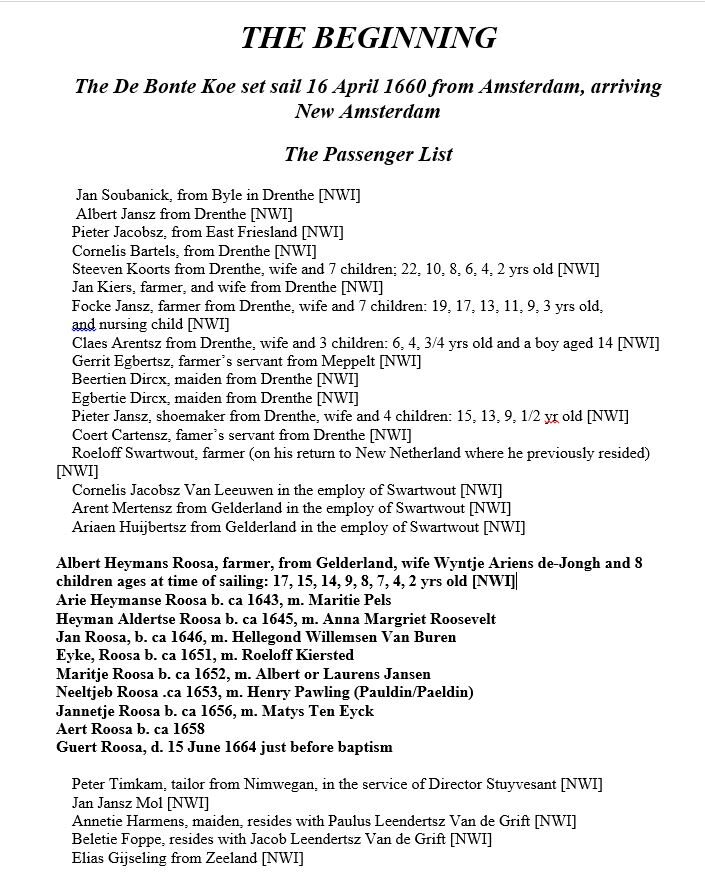
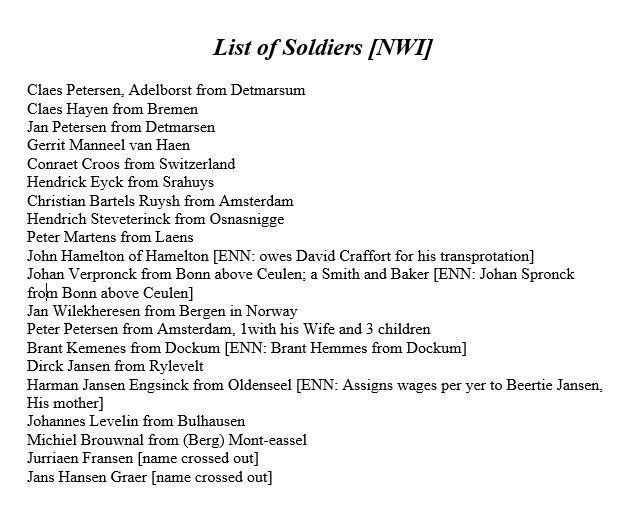
THE BEGINNING Part 2
The De Bonte Koe set sailed 16 April 1660 from Amsterdam, arriving New Amsterdam
Aldert (Albert, Alaerdt, Allard) Heymansen ROOSA, the founder of the Roosa family in America, was born in 1621 in Herwynen, Gelderland, Netherlands. With his wife and eight children, the Roosa’s arrived at New Netherland on 15 Apr 1660 on the ship “De Bonte Koe, “the Spotted Cow.” Aldert was a wealthy man for his day and brought considerable property with him and quickly “occupied an influential position in the new settlement.”
In the spring of 1661, he joined in a contract guaranteeing a salary to Domine Bloem who had been called as the regular pastor of the Dutch Church at Wiltwyck. Upon their arrival, Aldert secured passage for himself and his family to Esopus (Kingston) and took up residence in the Esopus District at Wiltwyck by 1664. When a new village was laid out, he removed there, and from that time to his death he resided at Hurley. At the destruction of the village of Hurley on 7 Jun 1663 by the Indians, two of the Roosa children with 43 others were taken captive. They were rescued by the colonial forces under the command of Captain Martin Kregier
After the surrender of the Dutch government to the English in 1664, Aldert led the revolt of the Burghers against military leaders. He and Cornelius Barentsen Slecht and two others were found guilty of a rebellious and mutinous riot at Esopus and were taken to New York for sentence. Roosa was to be banished for life out of the government and the others for shorter terms out of Esopus, Albany, and New York. Each of their sentences was later modified and the offenders returned to Esopus.
Governor Francis Lovelace restored Roosa to favor and in 1669 appointed him and Luis Du Bois two of overseers for Hurley (New Dorp) or New Village. Roosa also served in the military forces of the Colony as a mustering officer and in other capacities. He died 27 Feb1679 at Hurley, Ulster Co., NY.
He was married circa 1642 to Wyntje Ariens de Jonge, the daughter of Adrian Miertensen de Jonge and Maritje. Wyntje was born about 1630 probably in Holland.
On March 3, 1660 (1036) Albert, living in Herwijnen, conveyed half a tract of land as yet undivided between the heirs of Govert Ariensen De Jongh, in Hellouw ( a mile or so from Herwijnen) and again he pledged his interest in the estate of the late (2074) Adrian MeertensenDe Jongh as security for the fulfillment of the contract. It is further proof that the wife of (1036)Albert was the daughter of (2074) Adrian Meertensen De Jongh. The (2074) De Jongh family owned large fowler preserves in Hellouw in the 17th century. (1036) Albert and his family arrived in New Netherlands on April 15, 1660, aboard the good ship “De Bonte Koe” or “Spotted Cow”.He was a wealthy man for those days, bringing with him considerable property from Holland, and he speedily occupied an influential position in the new settlement. In the spring of 1661, he joined a contract guaranteeing a salary to Domine Bloem who had been called as the regular pastor of the Dutch Church at Wiltwyck.
For subsequent events, see The Esopus War, the Wiltwyck Massacre, and the Mutiny Against the English
(1036) Albert Heymans was banned from holding public office after the Esopus Mutiny. His sentence was subsequently modified, and he returned to Esopus. Governor Francis Lovelacerestored (1036) Roosa to favor and in 1669 appointed him as one of the Overseers for Hurley, called New Dorp or New Village. In 1673 he was confirmed as one of the officers at Esopus by Governor Anthony Colve and described as (1036) “Captain Albert Heymans, who had been prominent in the riot of 1667”. (1036) Albert served in the military forces of the Colony as a mustering officer and in other capacities and on April 5, 1670, at the military rendezvous held atMarbletown, he was present as Sergeant of Captain Henry Pawling’s Company which also appeared his son (518) Arie Roosa as private, and in 1673 (1036) Albert was Captain of a company recruited from Hurley and Marbletown.
Spouses
Children
Arie Heymanse Roosa b. ca 1643, m. Maritie Pels
Heyman Aldertse Roosa b. ca 1645, m. Anna Margriet Roosevelt
Jan Roosa, b. ca 1646, m. Hellegond Willemsen Van Buren
Eyke, Roosa b. ca 1651, m. Roeloff Kiersted
Maritje Roosa b. ca 1652, m. Albert or Laurens Jansen
Neeltjeb Roosa .ca 1653,m.Henry Pawling (Pauldin/Paeldin)
Jannetje Roosa b. ca 1656, m. Matys Ten Eyck
Aert Roosa b. ca 1658
Guert Roosa, d. 15 June 1664 just before baptism
The Beginning Part 3
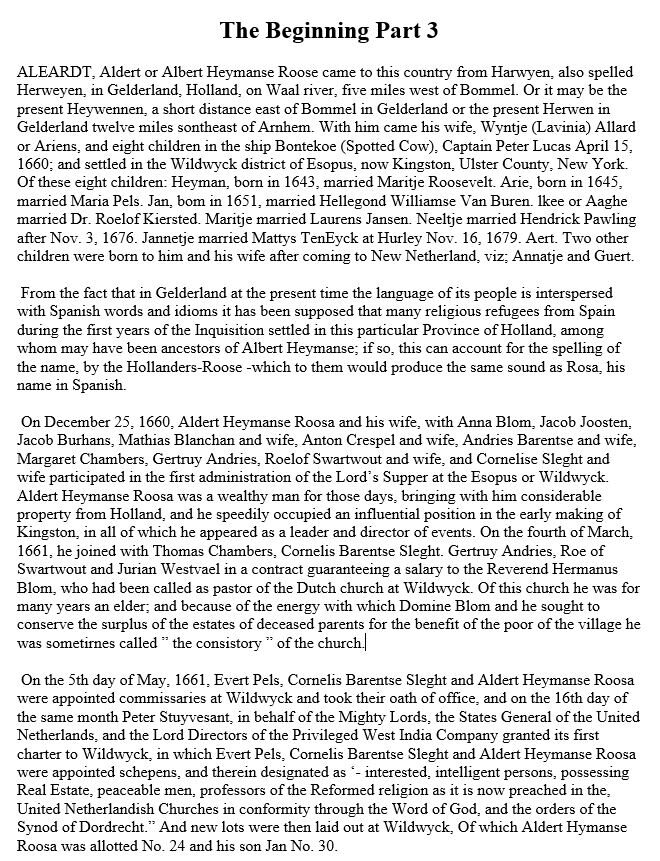
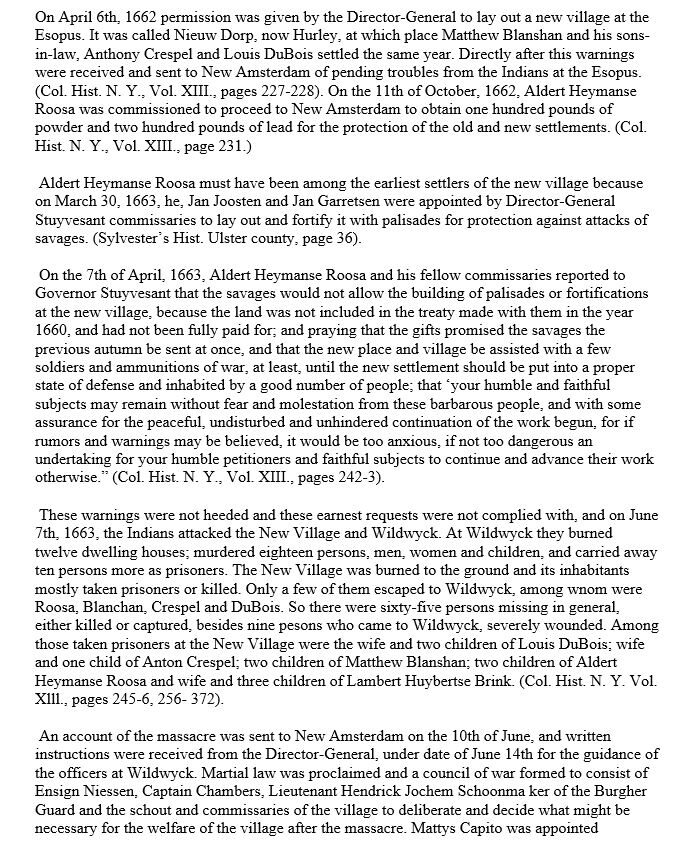
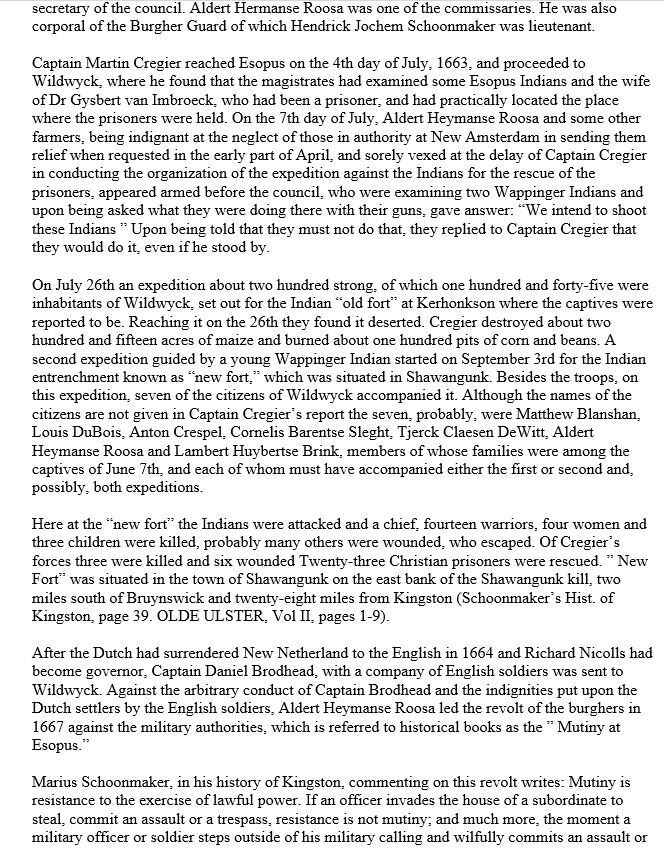
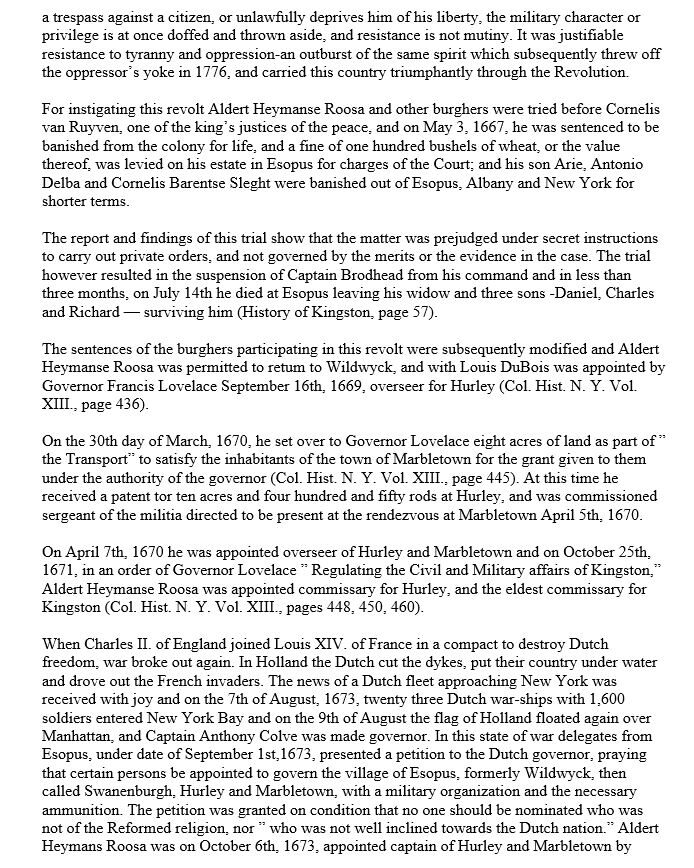
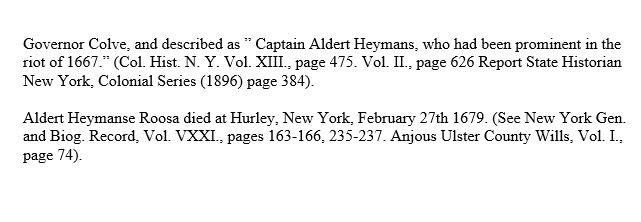
Reaching across 400 years to Hurley’s Early Dutch Settlers
by Patricia and Jeffery Burke | 4/29/2020
Introduction and Discovery
Patricia recently volunteered to be Chairperson of the Heraldry Committee at her local Chapter of Colonial Dames 17th Century. She soon learned Heraldry is a significant aspect of the society’s mission and having an approved Coat of Arms is an important part of their record-keeping.
While looking at a list of Colonists with approved Coats of Arms, we surprisingly discovered two of her ancestors were included: Aldert Hymans Roosa and his wife Wyntje Ariens de Jongh. To emphasize, in addition to the Roosa shield there is a separate one for Wyntje! Apparently, a Coat of Arms allowed a person the right to bear arms.
Historical Background
Aldert Hymans Roosa is the ancestor of the Roosa family in America. He and his wife Wyntje were born in Herwynen, Gilderland, Netherlands circa 1621 and 1623, respectively. They married about 1642 and with daring and their eight children, came to New Netherlands in 1660 on the ship De Bonte Koe (Spotted Cow), initially settling in Wiltwick/Esopus (now Kingston, NY) where he became a prominent and sometimes controversial citizen.
Roosa was an agriculturist and a wealthy man for those days, bringing with him considerable property from Holland, and he speedily occupied an influential position in the new settlement. For example, Aldert’s name appears with that of his son Arien Albertson Roosa, Louys Du Bois, and others to petition Sir Edmund Andros, Governor of New York, praying that he would assist them in procuring a minister for Esopus, “that can preache boitthe Inglish and Dutche which will be most fitting for this place, it being in its minority.” This effort was successful for on December 25, 1660, Aldert and Wyntje participated in the first administration of the Lord’s Supper given by the Rev. Harmanus Bloem, who had been called as the regular pastor of the Dutch Church at Wiltwyck. In the spring of 1661, Aldert joined in a contract guaranteeing a salary to Rev. Bloem.
In 1662, Roosa was appointed one of three commissioners to enclose the new village at the Esopus, called Nieuw Dorp (now Hurley). At the destruction of this village on June 7, 1663 “by the Indians,” two Roosa children were taken captive along with 43 other women and children.
Rebellion and Reprieve
It seems Aldert was not receptive of the emerging British influence and in 1667 he joined with Cornelis Barentsen Slecht and two others in a rebellious and mutinous riot. They were found guilty and taken to New York for sentence. Nichols, by advice of his council, on the 3rd of May, sentenced Heymans to be banished for life out of the government, and the others for shorter terms, out of Esopus, Albany, and New York. All these sentences of the burghers were subsequently modified, and the offenders returned to Esopus. Governor Francis Lovelace restored Roosa to favor and in 1669 appointed him and Louis Du Bois, two of the overseers for Hurley, formerly called Nieuw Dorp or New Village. “In 1673 he was confirmed as one of the officers at Esopus by Governor Anthony Colve, and described as Captain Albert Heymans, who had been prominent in the riot of 1667.”
Aldert and his family subsequently relocated to Hurley where he and Wyntje resided for the remainder of their lives. He died in 1678/79 and she died sometime after 1685 when she was recorded as securing a grant of 320 acres at Hurley.
Lineage
What is notable about Patricia’s lineage is that she is descended from Aldert and Wyntje on her father’s and mother’s side. Aldert and Wyntje had a son, Arie Hymansz Roosa who married Maria Evert Pels. They had several children including Wyntje Roosa (named after Arie’s mother), wife of Nicholas DePuy and they are direct ancestors of Patricia’s father, Alfred William O’Dea.
Arie and Maria had another daughter, Ariaantje Roosa, wife of Teunis Oosterhout and they are direct ancestors of Patricia’s mother, Grace Marion Chapman.
This lineage spanning 12 generations can be seen in Image #1. Note there are four American Revolutionary War soldiers represented here.
Heraldry
The governing authority for approving a Coat of Arms in America is the Committee on Heraldry of the New England Historic Genealogical Society located in Boston, MA. After reaching out to the Chairman, he responded by sending minutes of two meetings, in 1939 and 1940, that resulted in the approvals for Aldert and Wyntje. Interestingly, the application for these approvals was Marguerite du Pont Ortiz Boden (Mrs. Harry Clark Boden) of Newark, Delaware. She was a member of the du Pont family and was involved with many genealogical societies.
Reference Image #2 for Aldert and Wyntje’s approved Coats of Arms.
Summary
The confluence of separate lineages spanning 400 years and twelve generations is a genealogy treasure highlighted by the discovery of separate Coats of Arms awarded to Patricia’s 9th great-grandparents of the 17th Century and early Dutch colonists of Hurley.
Sources:
Historical Background, Rebellion and Reprieve
- 1888 The History of Kingston, New York, by M. Schoonmaker, p. 485
- 1891 Baptismal and Marriage Registers of the Old Dutch Church of Kingston, Ulster County, NY 1660-1809, by RR Hoes, #175, p. 11
- 1905 Pawling Genealogy, by AS Pawling, p. 13, 24-27
- 1910 New York Genealogical and Biographical Record, Vol. XXXI, “The Roosa Family of Ulster and Dutchess Counties, New York,” by Holdridge Ozro Collins, of Los Angeles, California, p. 163-166
- 1982 Genealogies of Pennsylvania Families from the Pennsylvania Genealogy Magazine, indexed by T. Holloway and E. Antoniak, p. 12
- 2019 homepages.rpi.edu (Albert Heymans Roosa)
Genealogy: - Patricia’s lineage to four American Revolutionary War Ancestors: National Society Daughters of the American Revolution; National No. 923650
- Patricia’s lineage from American Revolutionary War Ancestors to Aldert Hymans Roosa and Wintje Ariens de Jongh: Society of Colonial Dames XVII Century, submission to Colorado Registrar, 2020; National No. 42288
- Patricia’s Dutch lineage: Society of Holland Dames, Member No. 846
Roosa Military Service Record
Roosa Descendants
excerpt from the book by Arthur G. Roosa
In the war of 1776, The American Revolution, Abraham Roosa was a private soldier in the Second New York Regiment, Continental Line, Also in Col. Albert Pawling’s Regiment of new York Levies, and in the 2nd Regiment of Ulster County, New York, also a Sergeant in Col. Hathrom’s Regiment of New York Militia.
His son, Isaac A. Roosa was commissioned as Ensign in the 4th New York line, Nov. 21st. 1776, and a Lieutenant in the same Regiment, Nov. 9th, 1777. Resigned Jan. 22nd, 1778. Was Lieutenant in the exempts of Hanover, Ulster County, New York, Sept. 30,1778.
In the War of 1812, David Roosa, son of Isaac A. Roosa, was in Captain John Bogart’s Company of Col. Bevier’s Regiment, New York Militia from Sept. 5th , to December 18th, 1814.
Aldert Heyman Roosa, Born in Holland in 1621, came to this country from Gelderland, Holland, on Wall (Waal) River, five miles west of Brommel (Bommel), April 15th, 1660 with his wife Wyntge Areins and eight children, born in Holland in 1622, on the ship “Spotted Cow” in command of Captain Peter Lucas and settled in Wilt Wyck of Esopus, now Kingston, Ulster County, N.Y. He was a wealthy man and brought much property from Holland. He speedily achieved an influential position in the early making of Kingston. In all he appears as leader and director of events. On May 5th, 1661, he was appointed Commissioner of Wilt Wyck and took the oath of office 16th of May. Peter Stuyvesant in behalf of the Mighty Lords, the stated General and the Lord Directors of the United Netherlands, granted Wilt Wyck it’s first charter and Aldert Heyman Roosa was appointed Magistrate and therein designated an intelligent person. On the 11th of October, 1662, Roosa was commissioned to proceed to New Amsterdam to obtain 100 pounds of powder and 200 pounds of lead for the protection of the settlement. On April 7th, 1663, Roosa reported to Governor Stuyvesant that the savages were getting troublesome and suggested that the gifts promised them in the Treaty of 1660 be sent to them at once and a few soldiers and munitions of war to protect the settlement also be sent. The warning was not heeded and his earnest requests were not complied with and on the 7th day of June, 1663, the Indians attacked the New Village and Wilt Wyck. At Wilt Wyck they killed eighteen persons and took ten prisoners, burning twelve houses. New Village was burned to the ground. Out of seventy-eight inhabitants sixty-five were killed or taken prisoner. Roosa with twelve others escaped to Wilt Wyck. Of these nine were severely wounded. On July 26th an expedition two hundred strong started out to look for the Indians. Of this number 145 were inhabitants, leaving 36 soldiers in the garrison, but they failed to find the Indians. After burning 200 acres of corn and 100 pits of beans, they returned to Wilt Wyck.
On September 3rd a second expedition started out, besides the troops, the expedition included seven citizens of Wilt Wyck, of whom Roosa was one. The Indians were found on the Shawangumh Kill, twenty-eight miles from Wilt Wyck. The Indians were attacked. Their Chief and fourteen warriors, four white woman and three children were killed and twenty-three prisoners were rescued, among whom were Roosa’s two little girls, Elizabeth and Anita. The white women and children were killed in a crossfire in the battle.
After the Dutch had surrendered to the English in 1664, the English soldiers were sent to Wilt Wyck to replace the Dutch officials. In protest against the indignities put on the Dutch settlement by the English soldiers, Aldert Heyman Roosa, in 1667, led the revolt against the military authorities. For this Roosa was tried before one of the King Justices and was sentenced to be banished from the Colony for life and fined 100 bushels of wheat. It was afterwards proved that the trial was prejudiced and the English Captain was suspended (Captain Broadhead) and Roosa was returned. An outburst of the same spirit which threw off the oppression yoke in 1776 and carried this country triumphal through the Revolution. April 7th, 1670, he was appointed Overseer of Hurley and Marbletown and October 25th, 1671, by an order of Governor Loveler, Roosa was appointed Commissioner for Kingston. On the 7th day of August, 1673, twenty-three Dutch warships with 1600 soldiers entered New York Bay, and on the 9th the Dutch flag floated over Manhattan and Colonel Anthony Colve was made Governor and on October 6th, 1673, Aldert Heyman Roosa was appointed captain over Hurley and Marbletown by Colve and described as captain Aldert who had been prominent in the Revolt of 1667. Captain Roosa died at Hurley, on February 27th, 1679.
THE AMERICAN REVOLUTION
Roosa Patriots
The highest tribute to the departed is not grief but gratitude
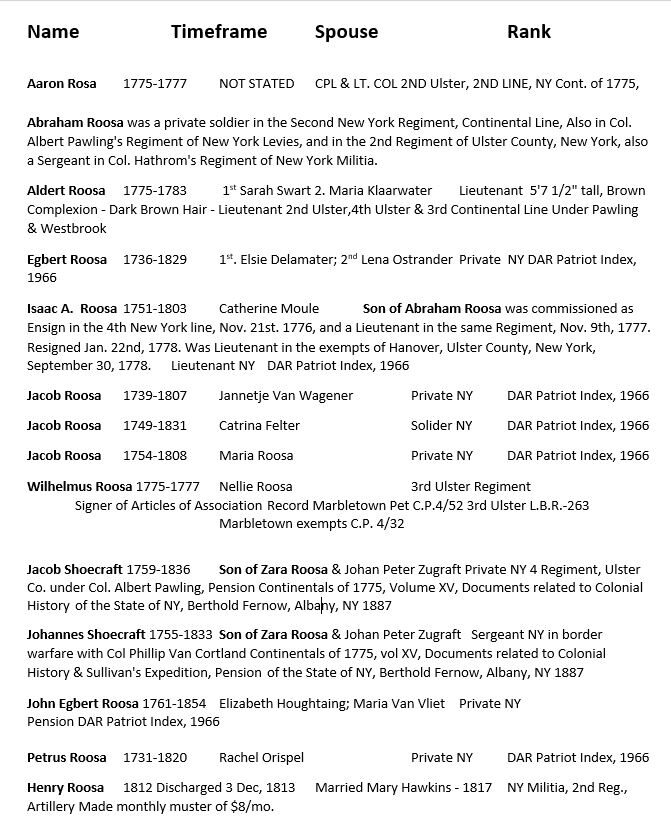
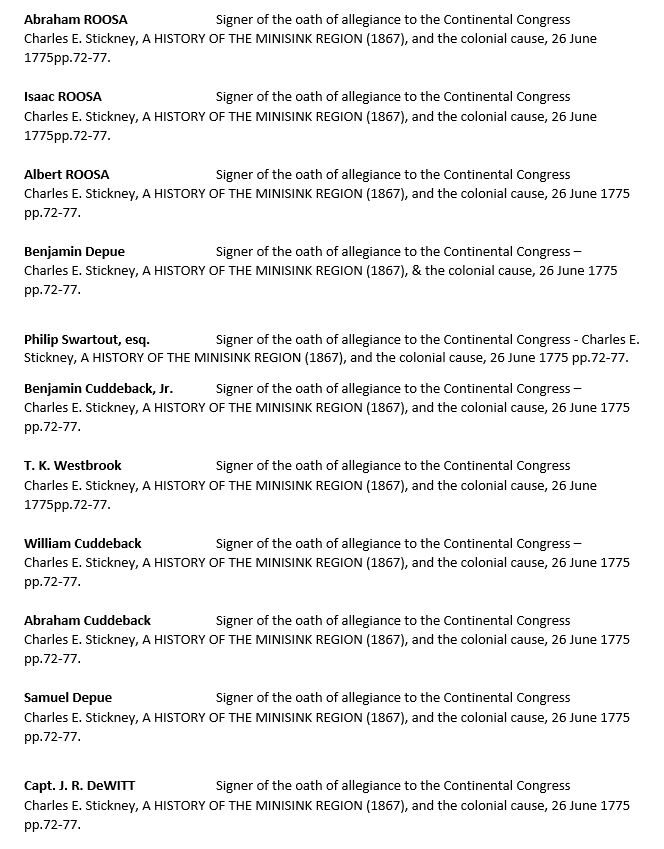
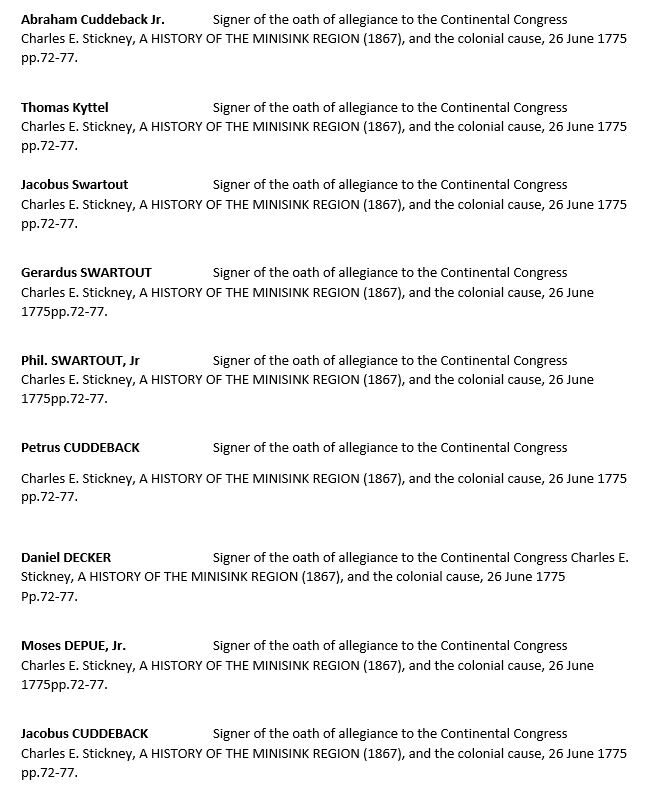
THE AMERICAN CIVIL WAR
Roosa Patriots
The highest tribute to the departed is not grief but gratitude
